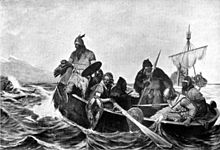Iceland is a Nordic island country in the North Atlantic Ocean and in the Arctic Ocean. Iceland is the most sparsely populated country in Europe. Iceland’s capital and largest city is Reykjavík, which (along with its surrounding areas) is home to over 65% of the population. Iceland is the biggest part of the Mid-Atlantic Ridge that rises above sea level, and its central volcanic plateau is erupting almost constantly. The interior consists of a plateau characterised by sand and lava fields, mountains, and glaciers, and many glacial rivers flow to the sea through the lowlands. Iceland is warmed by the Gulf Stream and has a temperate climate, despite a high latitude just outside the Arctic Circle. Its high latitude and marine influence keep summers chilly, and most of its islands have a polar climate.
According to the ancient manuscript Landnámabók, the settlement of Iceland began in 874 AD when the Norwegian chieftain Ingólfr Arnarson became the first permanent settler on the island. In the following centuries, Norwegians, and to a lesser extent other Scandinavians, immigrated to Iceland, bringing with them thralls of Gaelic origin.
The island was governed as an independent commonwealth under the native parliament, the Althing, one of the world’s oldest functioning legislative assemblies. Following a period of civil strife, Iceland acceded to Norwegian rule in the 13th century. The establishment of the Kalmar Union in 1397 united the kingdoms of Norway, Denmark, and Sweden. Iceland thus followed Norway’s integration into that union, coming under Danish rule after Sweden seceded from the union in 1523. The Danish kingdom forcefully introduced Lutheranism to Iceland in 1550.
In the wake of the French Revolution and the Napoleonic Wars, Iceland’s struggle for independence took form and culminated in the Danish–Icelandic Act of Union in 1918, with the establishment of the Kingdom of Iceland, sharing through a personal union the incumbent monarch of Denmark. During the occupation of Denmark in World War II, Iceland voted overwhelmingly to become a republic in 1944, thus ending the remaining formal ties with Denmark. Although the Althing was suspended from 1799 to 1845, the island republic has been credited with sustaining the world’s oldest and longest-running parliament.
Until the 20th century, Iceland relied largely on subsistence fishing and agriculture. Industrialization of the fisheries and Marshall Plan aid following World War II brought prosperity, and Iceland became one of the wealthiest and most developed nations in the world. It became a part of the European Economic Area in 1994; this further diversified the economy into sectors such as finance, biotechnology, and manufacturing.
Iceland has a market economy with relatively low taxes, compared to other OECD countries, as well as the highest trade union membership in the world. It maintains a Nordic social welfare system that provides universal health care and tertiary education for its citizens. Iceland ranks high in democracy and equality indexes, ranking third in the world by median wealth per adult. In 2021, it was ranked as the third-most developed country in the world by the United Nations’ Human Development Index, and it ranks first on the Global Peace Index. Iceland runs almost completely on renewable energy.
Icelandic culture is founded upon the nation’s Scandinavian heritage. Most Icelanders are descendants of Norse and Gaelic settlers. Icelandic, a North Germanic language, is descended from Old West Norse and is closely related to Faroese. The country’s cultural heritage includes traditional Icelandic cuisine, Icelandic literature, and medieval sagas. Iceland has the smallest population of any NATO member and is the only one with no standing army, with a lightly armed coast guard.
Etymology

Norsemen landing in Iceland – a 19th-century depiction by Oscar Wergeland
The Sagas of Icelanders say that a Norwegian named Naddodd (or Naddador) was the first Norseman to reach Iceland, and in the ninth century, he named it Snæland or “snow land” because it was snowing. Following Naddodd, the Swede Garðar Svavarsson arrived, and so the island was then called Garðarshólmur which means “Garðar’s Isle”.
Then came a Viking named Flóki Vilgerðarson; his daughter drowned en route, then his livestock starved to death. The sagas say that the rather despondent Flóki climbed a mountain and saw a fjord full of icebergs, which led him to give the island its new and present name. The notion that Iceland’s Viking settlers chose that name to discourage the settlement of their verdant isle is a myth.